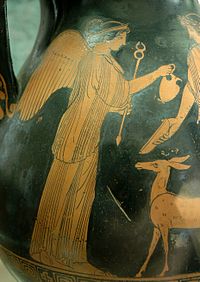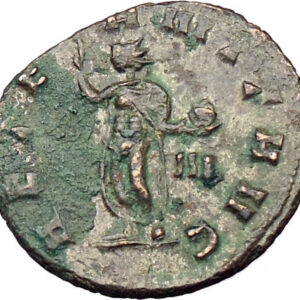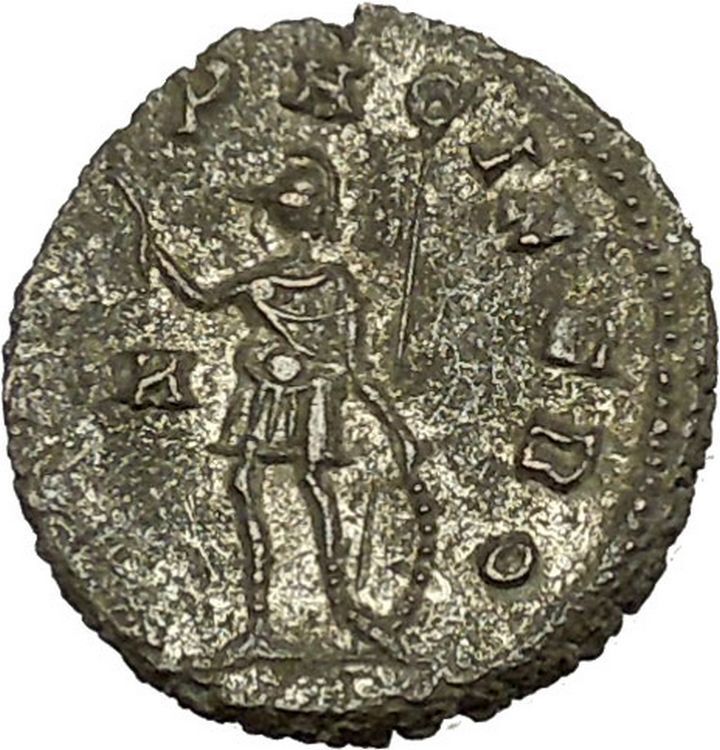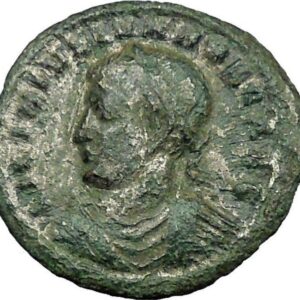|
Diocletian –
Roman Emperor
: 284-305 A.D. –
Silvered Bronze Follis 22mm (3.30 grams) Struck circa 284-305 A.D.
Reference: Possibly Unpublished
IMP DIOCLETIANVS AVG, radiate, draped, cuirassed bust right
FELICITAS AVG, Exe. XXIB – Felicitas standing left, holding caduceus
and cornucopia.
You are bidding on the exact item pictured,
provided with a Certificate of Authenticity and Lifetime Guarantee of
Authenticity.
The caduceus from
Greek
“herald’s staff” is the staff carried by
Hermes
in
Greek mythology
. The same staff was also borne
by heralds in general, for example by
Iris
, the messenger of
Hera. It is a short staff entwined by two
serpents
, sometimes surmounted by wings. In
Roman iconography it was often depicted being carried in the left hand of
Mercury
, the messenger of the gods, guide of
the dead and protector of merchants, shepherds, gamblers, liars, and thieves.
As a symbolic object it represents Hermes (or the Roman Mercury), and by
extension trades, occupations or undertakings associated with the god. In later
Antiquity
the caduceus provided the basis for
the
astrological symbol
representing the
planet Mercury
. Thus, through its use in
astrology
and
alchemy
, it has come to denote the
elemental metal
of the same name.
By extension of its association with Mercury/Hermes, the caduceus is also a
recognized symbol of commerce and negotiation, two realms in which balanced
exchange and reciprocity are recognized as ideals. This association is ancient,
and consistent from the Classical period to modern times. The caduceus is also
used as a symbol representing printing, again by extension of the attributes of
Mercury (in this case associated with writing and eloquence).
The caduceus is sometimes mistakenly used
as a symbol of medicine and/or medical practice
,
especially in
North America
, because of widespread confusion
with the traditional medical symbol, the
rod of Asclepius
, which has only a single snake
and no wings.
The term kerukeion denoted any herald’s staff, not necessarily
associated with Hermes in particular.
Lewis Richard Farnell
(1909) in his study of
the cult of Hermes assumed that the two snakes had simply developed out of
ornaments of the shepherd’s crook used by heralds as their staff. This view has
been rejected by later authors pointing to parallel iconography in the Ancient
Near East. It has been argued that the staff or wand entwined by two snakes was
itself representing a god in the pre-anthropomorphic era. Like the
herm
or
priapus
, it would thus be a predecessor of the
anthropomorphic Hermes of the classical era.
Ancient Near East
William Hayes Ward
(1910) discovered that
symbols similar to the classical caduceus sometimes appeared on
Mesopotamian cylinder seals
. He suggested the
symbol originated some time between 3000 and 4000 BCE, and that it might have
been the source of the Greek caduceus.[10]
A.L. Frothingham incorporated Dr. Ward’s research into his own work, published
in 1916, in which he suggested that the prototype of Hermes was an “Oriental
deity of Babylonian extraction” represented in his earliest form as a snake god.
From this perspective, the caduceus was originally representative of Hermes
himself, in his early form as the Underworld god
Ningishzida
, “messenger” of the “Earth Mother”.
The caduceus is mentioned in passing by
Walter Burkert
[12]
as “really the image of copulating snakes taken over from Ancient Near Eastern
tradition”.
In Egyptian iconography, the
Djed pillar is depicted as containing a snake in a frieze of the
Dendera Temple complex
.
The rod of Moses
and the
brazen serpent
are frequently compared to the
caduceus, especially as Moses is acting as a messenger of God to the
Pharaoh
at the point in the narrative where he
changes his staff into a serpent.[13]
Classical antiquity
Mythology
The
Homeric hymn
to Hermes relates how Hermes
offered his lyre fashioned from a tortoise shell as compensation for the
cattle he stole
from his half brother
Apollo
. Apollo in return gave Hermes the
caduceus as a gesture of friendship. The association with the serpent thus
connects Hermes to Apollo
, as later the serpent was associated
with Asclepius
, the “son of Apollo”. The association
of Apollo with the serpent is a continuation of the older
Indo-European
dragon
-slayer motif.
Wilhelm Heinrich Roscher
(1913) pointed out
that the serpent as an attribute of both Hermes and Asclepius is a variant of
the “pre-historic semi-chthonic serpent hero known at Delphi as
Python
“, who in classical mythology is slain by
Apollo.
One Greek myth of origin
of the caduceus is part of the
story of Tiresias
, who found two snakes copulating and
killed the female with his staff. Tiresias was immediately turned into a woman,
and so remained until he was able to repeat the act with the male snake seven
years later. This staff later came into the possession of the god Hermes, along
with its transformative powers.
Another myth suggests that Hermes (or Mercury) saw two serpents entwined in
mortal combat. Separating them with his wand he brought about peace between
them, and as a result the wand with two serpents came to be seen as a sign of
peace.
In Rome, Livy
refers to the caduceator who
negotiated peace arrangements under the diplomatic protection of the caduceus he
carried.
Iconography
In some vase paintings ancient depictions of the Greek kerukeion are
somewhat different from the commonly seen modern representation. These
representations feature the two snakes atop the staff (or rod), crossed to
create a circle with the heads of the snakes resembling horns. This old graphic
form, with an additional crossbar to the staff, seems to have provided the basis
for the graphical
sign of Mercury
(☿) used in
Greek astrology
from Late Antiquity.
Use in alchemy
and occultism
As the symbol of both the
planet
and the
metal
named for Mercury, the caduceus became an
important symbol in
alchemy
.
The
crucified serpent
was also revived as an
alchemical symbol for
fixatio
, and
John Donne
(Sermons 10:190) uses
“crucified Serpent” as a title of
Jesus Christ
.
Symbol of commerce
A simplified variant of the caduceus is to be found in dictionaries,
indicating a “commercial term” entirely in keeping with the association of
Hermes with commerce. In this form the staff is often depicted with two winglets
attached and the snakes are omitted (or reduced to a small ring in the middle).
The Customs Service of the former
German Democratic Republic
employed the
caduceus, bringing its implied associations with thresholds, translators, and
commerce, in the service medals they issued their staff.
Misuse as symbol
of medicine
It is relatively common, especially in the United States, to find the
caduceus, with its two snakes and wings, used as a symbol of medicine instead of
the correct rod of Asclepius, with only a single snake. This usage is erroneous,
popularised largely as a result of the adoption of the caduceus as its insignia
by the
US Army medical corps
in 1902 at the insistence
of a single officer (though there are conflicting claims as to whether this was
Capt. Frederick P. Reynolds or Col. John R. van Hoff).
The rod of Asclepius is the dominant symbol for professional healthcare
associations in the United States. One survey found that 62% of professional
healthcare associations used the rod of Asclepius as their symbol. The same
survey found that 76% of commercial healthcare organizations used the Caduceus
symbol. The author of the study suggests the difference exists because
professional associations are more likely to have a real understanding of the
two symbols, whereas commercial organizations are more likely to be concerned
with the visual impact a symbol will have in selling their products.
The initial errors leading to its adoption and the continuing confusion it
generates are well known to medical historians. The long-standing and abundantly
attested historical associations of the caduceus with commerce, theft,
deception, and death are considered by many to be inappropriate in a symbol used
by those engaged in the healing arts. This has occasioned significant criticism
of the use of the caduceus in a medical context.
In
Roman mythology
, Felicitas (meaning
“good luck” or “fortune”) was the goddess or personification of good luck and
success. The word felicitas, “luck”, is also the source of the word and
name felicity. She played an important role in
Rome’s state religion
during the
empire
, and was frequently portrayed on
coins
. She became a prominent symbol of the
wealth and prosperity of the
Roman Empire
.
Felicitas was unknown before the mid-2nd century BC, when a temple was
dedicated to her in the
Velabrum
in the
Campus Martius
by
Lucius Licinius Lucullus
, using booty from his
151–150 BC campaign in Spain. The temple was destroyed by a fire during the
reign of Claudius
and was never rebuilt.
Another temple in Rome
was planned by
Julius Caesar
and was erected after his death
by
Marcus Aemilius Lepidus
on the site of the
Curia Hostilia
, which had been restored by
Lucius Cornelius Sulla
but demolished by Caesar
in 44 BC. This temple no longer existed by the time of
Hadrian
, and its site probably lies under the
church of
Santi Martina e Luca
.
The cornucopia (from Latin cornu copiae) or horn of plenty
is a symbol of abundance and nourishment, commonly a large horn-shaped container
overflowing with produce, flowers, nuts, other edibles, or wealth in some form.
Originating in
classical antiquity
, it has continued as a
symbol in
Western art
, and it is particularly associated
with the
Thanksgiving
holiday in
North America
.

Allegorical
depiction of the Roman
goddess
Abundantia
with a cornucopia, by
Rubens
(ca. 1630)
In Mythology
Mythology
offers multiple
explanations of the origin
of the cornucopia.
One of the best-known involves the birth and nurturance of the infant
Zeus, who had to be hidden from his devouring father
Cronus
. In a cave on
Mount Ida
on the island of
Crete
, baby Zeus was cared for and protected by
a number of divine attendants, including the goat
Amalthea
(“Nourishing Goddess”), who fed him
with her milk. The suckling future king of the gods had unusual abilities and
strength, and in playing with his nursemaid accidentally broke off one of her
horns
, which then had the divine power to
provide unending nourishment, as the foster mother had to the god.
In another myth, the cornucopia was created when
Heracles
(Roman
Hercules
) wrestled with the river god
Achelous
and wrenched off one of his horns;
river gods were sometimes depicted as horned. This version is represented in the
Achelous and Hercules
mural painting
by the
American Regionalist
artist
Thomas Hart Benton
.
The cornucopia became the attribute of several
Greek
and
Roman deities
, particularly those associated
with the harvest, prosperity, or spiritual abundance, such as personifications
of Earth (Gaia
or
Terra
); the child
Plutus
, god of riches and son of the grain
goddess Demeter
; the
nymph
Maia
; and
Fortuna
, the goddess of luck, who had the power
to grant prosperity. In
Roman Imperial cult
, abstract Roman deities who
fostered peace (pax
Romana) and prosperity were also depicted with a cornucopia,
including Abundantia
, “Abundance” personified, and
Annona
, goddess of the
grain supply to the city of Rome
.
Pluto
, the classical ruler of the underworld in
the
mystery religions
, was a giver of agricultural,
mineral and spiritual wealth, and in art often holds a cornucopia to distinguish
him from the gloomier Hades
, who holds a
drinking horn
instead.
Modern depictions
In modern depictions, the cornucopia is typically a hollow, horn-shaped
wicker basket filled with various kinds of festive
fruit
and
vegetables
. In North America, the cornucopia
has come to be associated with
Thanksgiving
and the harvest. Cornucopia is
also the name of the annual November Wine and Food celebration in
Whistler
, British Columbia, Canada. Two
cornucopias are seen in the
flag
and
state seal
of
Idaho
. The Great
Seal
of
North Carolina
depicts Liberty standing and
Plenty holding a cornucopia. The coat of arms of
Colombia
,
Panama
,
Peru and
Venezuela
, and the Coat of Arms of the State of
Victoria, Australia
, also feature the
cornucopia, symbolising prosperity.
The horn of plenty is used on body art and at Halloween, as it is a symbol of
fertility, fortune and abundance.

Gaius
Aurelius Valerius Diocletianus (c. 22 December 244 – 3
December 311),
born Diocles and commonly known as
Diocletian, was
Roman
Emperor
from 20 November 284 to 1 May 305. Born to a
Dalmatian
family of low status, he rose through the ranks of the military to become
cavalry commander to the emperor
Carus
. After the
deaths of Carus and his son
Numerian
on
campaign in Persia, Diocletian was acclaimed emperor by the army. A brief
confrontation with Carus’ other surviving son
Carinus
at
the
Battle of the Margus
removed the only other claimant to the title. With his
ascension to power, he ended the
Crisis of the Third Century
. Diocletian appointed fellow-officer
Maximian
his
Augustus
, his senior co-emperor, in 285. He delegated further on 1 March
293, appointing Galerius
and
Constantius
as
Caesars
, junior co-emperors. Under this “Tetrarchy“,
or “rule of four”, each emperor would rule over a quarter-division of the
empire. In campaigns against
Sarmatian
and Danubian
tribes (285–90), the
Alamanni
(288), and usurpers in
Egypt
(297–98), Diocletian secured the empire’s borders and purged it of
threats to his power. In 299, Diocletian led negotiations with
Sassanid Persia
, the empire’s traditional enemy, and achieved a lasting and
favorable peace.
Diocletian separated and enlarged the empire’s civil and
military services and re-organized the empire’s provincial divisions,
establishing the largest and most
bureaucratic
government in the history of the empire. He established new
administrative centers in
Nicomedia
,
Mediolanum
,
Antioch
, and
Trier
, closer to
the empire’s frontiers than the traditional capital at Rome had been. Building
on third-century trends towards absolutism, Diocletian styled himself an
autocrat, elevating himself above the empire’s masses with imposing forms of
court ceremonial and architecture. Bureaucratic and military growth, constant
campaigning, and construction projects increased the state’s expenditures, and
necessitated a comprehensive tax reform. From at least 297 on, imperial taxation
was standardized, made more equitable, and levied at generally higher rates.
Not all Diocletian’s plans were successful; the
Edict on Maximum Prices
(301), Diocletian’s attempt to curb
inflation
via price controls
, was unsuccessful, counterproductive, and quickly ignored.
Although effective while he ruled, Diocletian’s Tetrarchic system collapsed
after his abdication under the competing dynastic claims of
Maxentius
and Constantine
, sons of Maximian and Constantius respectively. The
Diocletianic Persecution
(303–11), the empire’s last, largest, and bloodiest
official persecution of
Christianity
, did not destroy the empire’s Christian community; indeed,
after 324 Christianity became the empire’s preferred religion under its first
Christian emperor,
Constantine
. In spite of his failures, Diocletian’s reforms fundamentally
changed the structure of Roman imperial government and helped stabilize the
empire economically and militarily, enabling an empire that had seemed near the
brink of collapse in Diocletian’s youth to remain essentially intact for another
hundred years. Weakened by illness, Diocletian left the imperial office on May
1, 305, and became the first Roman emperor to voluntarily abdicate the position.
He lived out his retirement in
his palace
on the Dalmatian coast, tending to his vegetable gardens. His
palace went on to become the core of the modern day city of
Split
//
|












